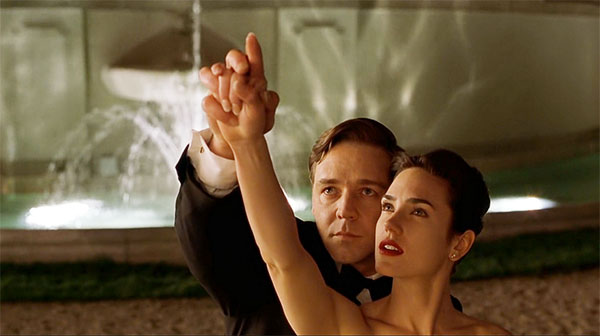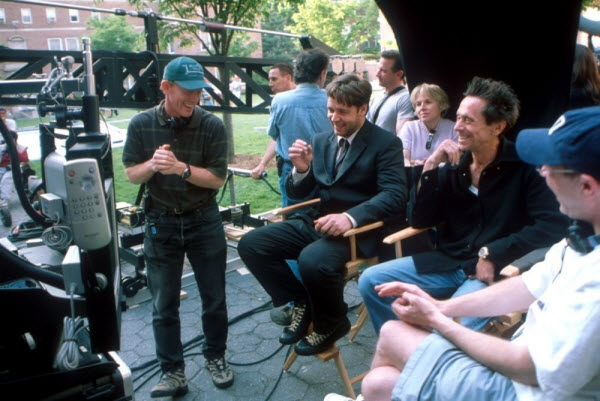A Beautiful Mind is a powerful and inspirational film that explores the life of Nobel Prize-winning mathematician John Nash. Directed by Ron Howard, this 2001 film is a remarkable portrayal of brilliance, mental illness, and redemption. Building on the true story of Nash, the film delves into his struggles with schizophrenia while showcasing his profound contributions to mathematics and his personal journey towards triumph.
Plot Summary (Warning: Spoilers Ahead)

“A Beautiful Mind” chronicles the life of John Nash (Russell Crowe), a mathematical prodigy whose genius is overshadowed by his struggle with schizophrenia. The film starts with Nash’s early years at Princeton University, where he develops his groundbreaking game theory. His work attracts attention, and he is soon on the path to academic success.
Nash’s life takes a dramatic turn as he begins to experience paranoid delusions and hallucinations. He believes that he is being recruited by a secret government organization to decipher codes and prevent Soviet attacks. This paranoia strains his relationships, especially with his wife Alicia (Jennifer Connelly), who stands by him through his darkest moments.
As Nash’s condition worsens, he undergoes a series of treatments, including insulin shock therapy, which exacerbates his difficulties. Despite these challenges, Nash eventually learns to manage his illness with the support of Alicia and his academic community. He returns to teaching and continues his work in mathematics. The film concludes with Nash receiving the Nobel Prize in Economic Sciences, recognizing his contributions to game theory and his perseverance through personal adversity.
Main Characters and Actors:
- John Nash (Russell Crowe): The central figure of the film, Nash is portrayed as a brilliant but troubled mathematician whose battle with schizophrenia shapes his life.
- Alicia Nash (Jennifer Connelly): John’s supportive and compassionate wife who helps him navigate his illness and academic career.
- Dr. Rosen (Christopher Plummer): Nash’s psychiatrist who provides medical treatment and guidance.
- Charles Herman (Paul Bettany): Nash’s college roommate and best friend, who later appears as a figment of Nash’s imagination.
- William Parcher (Ed Harris): A mysterious figure who represents Nash’s delusional world of government conspiracies.
Awards and Recognition:
A Beautiful Mind was a critical and commercial success, winning four Academy Awards including Best Picture, Best Director (Ron Howard), Best Supporting Actress (Jennifer Connelly), and Best Adapted Screenplay (Akiva Goldsman). The film was praised for its portrayal of mental illness, its engaging narrative, and its performances, particularly those of Russell Crowe and Jennifer Connelly. It remains an influential film in the genre of biographical dramas.
. Musical Score: James Horner’s score contributed significantly to the film’s emotional and dramatic impact.
Trivia (100 Interesting Facts):

- Nobel Prize Winner: The film portrays John Nash’s real-life achievement of winning the Nobel Prize in Economic Sciences in 1994.
- Real Nash’s Involvement: John Nash and his wife Alicia were consultants on the film, providing authenticity to the portrayal of their lives.
- Schizophrenia Portrayal: The film’s depiction of schizophrenia was praised for its accuracy, though some elements were dramatized.
- Russell Crowe’s Commitment: Russell Crowe underwent significant physical transformation for the role, including weight loss to portray Nash during his illness.
- Jennifer Connelly’s Award: Jennifer Connelly won the Academy Award for Best Supporting Actress for her role as Alicia Nash.
- Real-life Friends: Charles Herman, portrayed by Paul Bettany, was based on a real friend of Nash, though the character was fictionalized in the film.
- Screenplay Adaptation: The screenplay, written by Akiva Goldsman, was based on Sylvia Nasar’s biography of John Nash.
- Director’s Vision: Ron Howard wanted to focus on Nash’s personal struggles and triumphs rather than just his mathematical achievements.
- Historical Accuracy: Some of Nash’s hallucinations and experiences were dramatized or fictionalized for cinematic effect.
- Film Locations: Princeton University, where Nash studied, was used for filming many of the academic scenes.
- Oscars Sweep: The film won four Academy Awards but was nominated for eight, including Best Actor (Russell Crowe) and Best Film Editing.
- Nash’s Real Family: John Nash’s real family members made brief appearances in the film.
- Mathematical Concepts: The film features Nash’s work on game theory, which had a significant impact on economics and mathematics.
- Set Design: The film’s set designers recreated Princeton’s iconic architecture to authentically portray the academic environment.
- Cameo Appearance: Sylvia Nasar, the author of the book, makes a cameo appearance in the film.
- Film Editing: The film’s editing was praised for its ability to depict Nash’s psychological state and transitions between reality and hallucination.
- Paul Bettany’s Role: Bettany’s portrayal of Charles Herman was integral in depicting Nash’s early academic life and social interactions.
- Ron Howard’s Approach: Howard’s direction focused on making Nash’s internal struggles accessible to audiences without sensationalizing his illness.
- Russell Crowe’s Research: Crowe conducted extensive research on schizophrenia and met with individuals suffering from the condition to prepare for his role.
- Inspiration: The film inspired numerous discussions and educational programs on mental health and the portrayal of mental illness in media.
- Nash’s Struggles: The film depicts Nash’s struggle with hallucinations as a central element of his personal and professional life.
- Cultural Impact: The film contributed to a greater public understanding of schizophrenia and mental health issues.
- Jennifer Connelly’s Performance: Connelly’s performance was noted for its emotional depth and authenticity.
- Original Score: James Horner composed the film’s score, which was nominated for an Academy Award.
- Biographical Accuracy: While the film took creative liberties, it remained largely faithful to Nash’s life and achievements.
- Real Therapy: The depiction of insulin shock therapy in the film was based on real treatments Nash underwent.
- Screenwriting Awards: Akiva Goldsman’s adaptation of Nasar’s book was acclaimed for its compelling and insightful screenplay.
- Russell Crowe’s Nomination: Crowe was nominated for the Best Actor Academy Award but did not win.
- Cinematic Techniques: The film used innovative cinematographic techniques to portray Nash’s distorted perception of reality.
- Public Reaction: The film received widespread praise for its respectful and nuanced portrayal of mental illness.
- Fictional Elements: The character of William Parcher was a fictional creation to represent Nash’s delusional experiences.
- Filming Challenges: The film’s depiction of Nash’s hallucinations posed unique challenges for the production team.
- Nash’s Legacy: The film helped raise awareness about Nash’s contributions to mathematics and his personal journey.
- International Recognition: The film was well-received globally and contributed to discussions about mental health and biographical storytelling.
- Inspirational Message: The film’s message of perseverance and redemption resonated with audiences and critics alike.
- Film’s Impact: The film had a lasting impact on public perceptions of schizophrenia and mental illness.
- Character Development: The film’s portrayal of Nash’s personal growth was a key element of its narrative.
- Visual Effects: The film used visual effects to represent Nash’s hallucinations and mental state.
- Film Festival: A Beautiful Mind premiered at the 2001 Toronto International Film Festival.
- Nash’s Personal Insight: John Nash’s personal insights and experiences added depth to the film’s portrayal of his life.
- Casting Choices: The casting of Russell Crowe and Jennifer Connelly was praised for their strong performances.
- Nash’s Nobel Prize: The film depicted Nash’s Nobel Prize win as a culmination of his professional and personal struggles.
- Ron Howard’s Previous Work: Howard’s experience directing biographical dramas contributed to the film’s authenticity.
- Real-Life Relationships: The film explored Nash’s relationships with family and colleagues, highlighting their impact on his life.
- Box Office Success: The film was a commercial success, grossing over $313 million worldwide.
- Critical Acclaim: The film received positive reviews for its performances, direction, and screenplay.
- Historical Context: The film’s release during a time of increased awareness about mental health added to its relevance.
- Innovative Storytelling: The film’s narrative structure, alternating between reality and hallucinations, was innovative for its time.
- Film’s Legacy: A Beautiful Mind remains a significant film in the genre of biographical dramas.
- Mathematical Accuracy: The film accurately depicted some of Nash’s mathematical theories and contributions.
- Real-Life Inspirations: The film’s portrayal of Nash’s achievements and struggles was inspired by real events and people.
- Production Design: The production design team recreated the 1950s and 1960s academic environment with great attention to detail.
- Emotional Impact: The film’s emotional portrayal of Nash’s personal and professional life had a profound impact on audiences.
- Educational Influence: The film has been used in educational settings to discuss mental health and biographical storytelling.
- Director’s Approach: Ron Howard’s approach to directing emphasized the human aspects of Nash’s story.
- Audience Reception: The film’s portrayal of mental illness and academic achievement was well-received by both audiences and critics.
- Cultural References: The film referenced real-life events and figures related to Nash’s life and work.
- Musical Score: James Horner’s score contributed significantly to the film’s emotional and dramatic impact.
- Film Awards: In addition to its Academy Awards, the film won numerous other awards and nominations.
- John Nash’s Real Achievements: The film accurately depicted Nash’s groundbreaking work in game theory.
- Visual Representation: The film used visual effects to represent Nash’s mental state and hallucinations.
- Critical Analysis: The film has been subject to extensive critical analysis and discussion.
- Public Awareness: The film increased public awareness of schizophrenia and mental health issues.
- Russell Crowe’s Preparation: Crowe’s preparation for the role involved extensive research and interviews with mental health professionals.
- Real-Life Challenges: The film’s portrayal of Nash’s challenges was based on real experiences and difficulties.
- Film’s Reception: The film was well-received for its performances, direction, and narrative.
- Educational Impact: The film has been used in educational settings to discuss mental health and biographical storytelling.
- Authentic Depiction: The film’s depiction of Nash’s academic achievements and personal struggles was widely praised for its authenticity.
- Cinematic Innovation: The film’s innovative storytelling techniques contributed to its critical and commercial success.
- Real-Life Inspiration: The film was inspired by John Nash’s real-life experiences and achievements.
- Cultural Impact: The film had a significant impact on public perceptions of mental illness and biographical storytelling.
- Nash’s Contributions: The film highlighted Nash’s significant contributions to mathematics and economics.
- Character Dynamics: The film explored the dynamics between Nash and his family, highlighting their impact on his life.
- Critical Praise: The film received critical praise for its performances, direction, and screenplay.
- Historical Context: The film’s release during a time of increased awareness about mental health added to its relevance.
- Cinematic Techniques: The film used innovative cinematic techniques to portray Nash’s mental state and hallucinations.
- Film’s Influence: The film influenced discussions about mental health and biographical storytelling.
- Nash’s Real Family: The film’s portrayal of Nash’s family was based on real-life relationships and experiences.
- Box Office Performance: The film’s box office success contributed to its widespread impact and recognition.
- Educational Use: The film has been used in educational settings to discuss mental health and biographical storytelling.
- Emotional Depth: The film’s emotional depth and portrayal of Nash’s struggles were widely praised.
- Real-Life Inspiration: The film’s portrayal of Nash’s achievements and struggles was inspired by real events and people.
- Innovative Storytelling: The film’s innovative storytelling techniques contributed to its critical and commercial success.
- Character Development: The film’s portrayal of Nash’s personal growth and achievements was a key element of its narrative.
- Film’s Legacy: A Beautiful Mind remains a significant film in the genre of biographical dramas.
- Russell Crowe’s Research: Crowe’s extensive research for the role added depth to his portrayal of John Nash.
- Nash’s Personal Insights: The film’s portrayal of Nash’s personal insights and experiences added authenticity to the narrative.
- Critical Acclaim: The film received critical acclaim for its performances, direction, and screenplay.
- Public Reception: The film’s portrayal of mental illness and academic achievement resonated with audiences and critics.
- Film Awards: A Beautiful Mind won four Academy Awards and received numerous other accolades.
- Real-Life Events: The film depicted real-life events and achievements of John Nash.
- Film’s Impact: The film had a lasting impact on public perceptions of mental illness and biographical storytelling.
- Authentic Portrayal: The film’s portrayal of Nash’s academic achievements and personal struggles was praised for its authenticity.
- Educational Influence: The film has been used in educational settings to discuss mental health and biographical storytelling.
- Emotional Impact: The film’s emotional portrayal of Nash’s struggles and achievements had a profound impact on audiences.
- Critical Analysis: The film has been the subject of extensive critical analysis and discussion.
- Public Awareness: The film increased public awareness of schizophrenia and mental health issues.
- Russell Crowe’s Preparation: Crowe’s preparation for the role involved extensive research and interviews with mental health professionals.
- Film’s Reception: The film was well-received for its performances, direction, and narrative.
- Cultural Impact: The film had a significant impact on public perceptions of mental illness and biographical storytelling.
